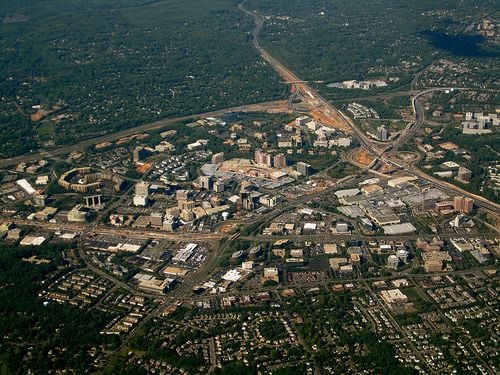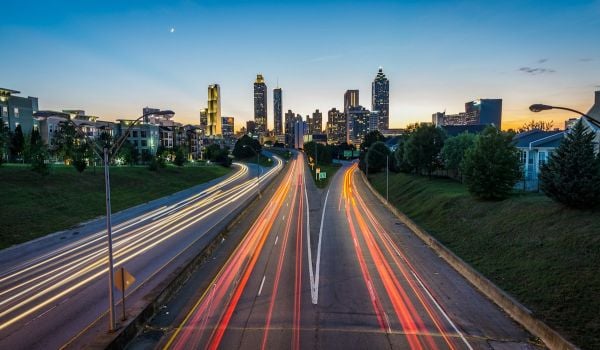This piece originally ran on Greater Greater Washington.
Virginia’s Fairfax County is planning to turn Tysons Corner, a commercial suburb just outside the District of Columbia, into a dense, walkable, urban center. This transformation will include the creation of street grid and better bike and pedestrian facilities. But two major thoroughfares will weaken pedestrian circulation and divide the new Tysons in two.
Route 123 and Route 7 are major six-lane roads running through the heart of Tysons Corner. The Silver Line, a planned extension of the D.C. Metro, will run along portions of either road, meaning that many pedestrians will be entering Tysons along these arteries.
But the construction of the Silver Line through Tysons Corner isn’t the only work being done in the corridor. Fairfax County is currently widening Route 123 from six to eight lanes.
The creation of a grid of streets coupled with bike/pedestrian improvements is necessary to facilitate movement within an urban Tysons, particularly to and from the Metro stations. The widening of 123, however, moves Tysons Corner in the opposite direction.
As a pedestrian, crossing six lanes of a major arterial road can be daunting. Adding an additional lane in each direction can make it even more difficult. Since Route 123 runs parallel to the Silver Line through the middle of Tysons, residents and employees will inevitably need to cross this busy street.
Last week the National Building Museum in D.C. hosted an event on the Tysons redevelopment plan. Matt Ladd, a Fairfax County planner, said that lanes on 123 are 12 feet wide. The plan calls for a reduction to 11 feet, but that still means pedestrians would have to cross an 88-foot road, not counting any turn lanes.
This certainly isn’t impossible. Infrastructure improvements like pedestrian islands and leading pedestrian intervals can make crossing easier. The problem is that crossing major streets like this isn’t attractive and it makes for a pedestrian-hostile space.
Ladd also mentioned that the county’s plan calls for wide sidewalks and a double row of trees along 123. These additions will make walking along the road more pleasant but don’t make it any easier to cross.
Crossing 123 will be even more difficult at the Tysons Central 7 metro station because the tracks are at grade. Pedestrians will either have to cross over or under the tracks to get from side to side. Again, this isn’t an impossible scenario. But if the county wants to make Tysons a walkable, accessible urban space, it will have to solve these barrier problems.
Today’s Tysons lacks any real neighborhoods, in large part because of wide roads, on-ramps, mega-blocks, parking garages and other major built environment factors that break up any coherent community. The new urban Tysons will overcome some of these, but a major eight-lane highway will act as an abrupt and unnatural edge to any future neighborhoods or districts that will stunt their growth and weaken them.
If residents find it too difficult or unpleasant to cross major roads, they may choose to patronize businesses on their side or use parks that are easier to reach. The physical division can also create social divisions and isolate communities.
The county can’t just rip up state highways, so the roads will always be an issue. But planners must be careful to prevent the roads from becoming enormous barriers to a true urban space. The county could narrow the lanes further and convert one lane for street parking.
Ladd suggested that because the county is planning for redevelopment over 40 years, these options could become a reality at some point. Hopefully the county doesn’t wait that long to solve the problem. Encouraging strong urban growth in a transit-oriented Tysons Corner should be a priority now, not decades down the road.





_600_350_80_s_c1.jpg)










